October 14, 2016
Air Date: October 14, 2016
FULL SHOW
SEGMENTS
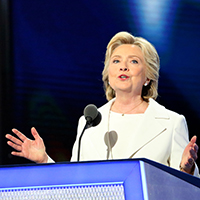
Clinton's Green Agenda
View the page for this story
In the second 2016 Presidential debate and at a rally in Florida, Democratic presidential candidate Hillary Clinton laid out her vision for an economy built on clean energy and a country resilient in the face of climate threats. Citing natural gas as a bridge fuel, she offered a plan to help communities transition away from coal. Clinton also reminded voters that Republican candidate Donald Trump once said climate change is “a hoax created by the Chinese” and she warned of the dangers of electing climate deniers to the White House and Congress. (11:00)
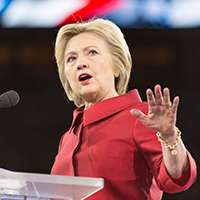
Breaking Down Clinton’s Climate Approach
View the page for this story
Living on Earth Host Steve Curwood checks in with Harvard Kennedy School Professor and former Obama administration climate and energy adviser Joe Aldy for analysis of Clinton’s plans. They discuss how she could get her ambitious climate agenda done, including how she might be able to persuade Congress to fund it. Prof. Aldy also considers her position on fracking, and her $30 billion plan to revitalize Appalachian coal country communities. (11:00)
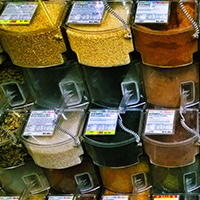
The Fillery: Shopping Without Waste
View the page for this story
Modern packaging means that shoppers often need to buy a 4-pound bag of specialty flour when they only need one cup for a recipe. So Sarah Metz has founded the Fillery, a new store focused on reducing waste, due to open in Brooklyn later this year. Metz explains to host Steve Curwood that at the Fillery, shoppers will bring their own reusable containers and only buy what they need. (08:00)
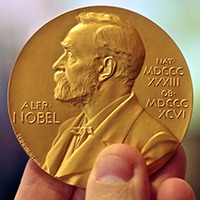
Beyond The Headlines
/ Peter DykstraView the page for this story
Beyond the Headlines this week, host Steve Curwood and Peter Dykstra note that contrary to dire predictions of the future as coal use was reduced, electricity prices have gone down. Also, sales of plug-in electric vehicles have climbed recently and they comment that all this year’s American scientists who won Nobel prizes are immigrants. Then they look back on the 1973 Arab oil embargo that brought soaring gas prices, the 55 mph speed limit, and actually saved lives. (04:20)

Science Note: Ancient Turtle Revelation
/ Charlotte RuttyView the page for this story
A new fossil found by an eight-year-old boy is helping researchers discern the origins of turtle shells. The specimen suggests that shells arose from an adaptation for burrowing underground and that only later did they acquire a protective function. (02:10)
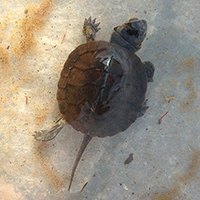
Turtles Hatch!
/ Don LymanView the page for this story
Blanding’s turtles are considered a threatened species in Massachusetts, so the nonprofit Grassroots Wildlife Conservation is working to protect newly hatched turtles, as mortality is high in the first year. Living on Earth’s Don Lyman returns to the nest we observed in June with the biologists to find out how many eggs hatched, and help prepare the young turtles for their next adventure in local classrooms. (11:05)
Show Credits and Funders
Show Transcript
HOST: Steve Curwood
GUESTS: Joseph Aldy, Sarah Metz
REPORTERS: Don Lyman, Charlotte Rutty, Peter Dykstra
[THEME]
CURWOOD: From Public Radio International, this is Living on Earth.
[THEME]
CURWOOD: I'm Steve Curwood. The US national elections are coming up fast -- and for some, the policies of the candidates are coming into sharp focus. When it comes to the environment and climate change, democratic presidential hopeful Hillary Clinton says there’s a stark difference.
CLINTON: This election matters more than any has in a really long time. Climate change needs to be a voting issue. Donald Trump is, quote, "Not a big believer in climate change." [AUDIENCE BOOS] We cannot risk putting a climate denier in the White House. At all. That is absolutely unacceptable. [CHEERING]
CURWOOD: We listen to and analyze Secretary Clinton’s words and plans for our climate and energy future. We’ll have that and more this week, on Living on Earth. Stick around.
[NEWSBREAK MUSIC: Boards Of Canada “Zoetrope” from “In A Beautiful Place Out In The Country” (Warp Records 2000)]
[THEME]
Clinton's Green Agenda
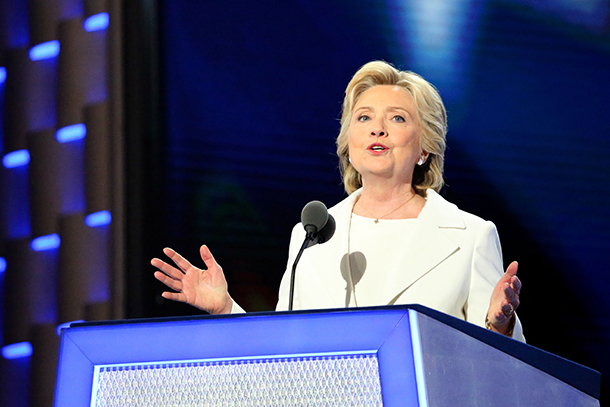
Hillary Clinton speaking at the Democratic National Convention this July (Photo: Ali Shaker/Voice of America CC government work)
CURWOOD: From the Jennifer and Ted Stanley Studios at the University of Massachusetts Boston and PRI, this is Living on Earth. I’m Steve Curwood. As the U.S. national elections draw near, we are taking a look at the environmental records and plans of the presidential candidates. We have already spoken with Green Party candidate Dr. Jill Stein, and reported where the Republican ticket led by Donald Trump stands. Today, we turn to the democrat, Hillary Clinton. We begin with energy, with comments she made at the second Presidential debate on October 9, when moderators Martha Raddatz and Anderson Cooper called on coal industry worker Ken Bone to pose a question.
BONE: What steps will your energy policy take to meet our energy needs, while at the same time remaining environmentally friendly and minimizing job loss for fossil power plant workers?
CLINTON: You know, because it sounds like you’re in the business or you’re aware of people in the business, you know that we are now -- for the first time ever -- energy independent. We are not dependent upon the Middle East, but the Middle East still controls a lot of the prices, so the price of oil has been way down. And that has had a damaging effect on a lot of the oil companies, right? We are, however, producing a lot of natural gas, which serves as a bridge to more renewable fuels, and I think that’s an important transition. So I have a comprehensive energy policy, but it really does include fighting climate change, because I think that is a serious problem. And I support moving toward more clean, renewable energy as quickly as we can, because I think we can be the 21st century clean energy superpower and create millions of new jobs and businesses.
CURWOOD: Secretary Clinton noted that the coal industry is already in trouble so she plans to help revitalize coal mining communities.
CLINTON: Because those coal miners, and their fathers and their grandfathers, they dug that coal out, a lot of them lost their lives, they were injured; but they turned the lights on and they powered our factories. I don’t want to walk away from them. So we’ve got to do something for them.
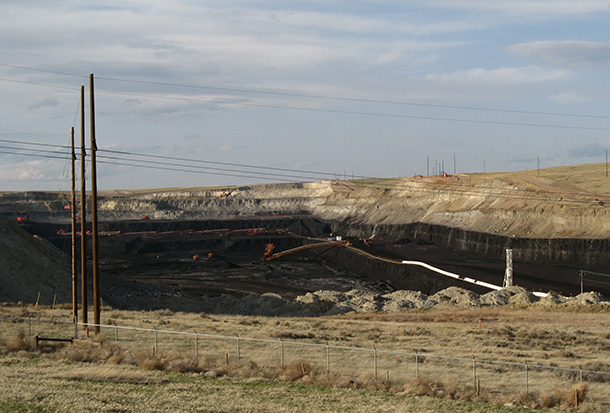
In her answer to citizen Ken Bone’s question about energy and jobs at the second 2016 presidential debate, Clinton pointed to her plan to revitalize communities that transition away from coal. (Photo: Greg Goebel, Flickr CC BY-SA 2.0)
CURWOOD: Just two days after the debate, Secretary Clinton traveled to Florida in the immediate aftermath of Hurricane Matthew. With former Vice President Al Gore in tow, she reminded voters that every vote counts: Mr. Gore lost Florida by just a few hundred votes in 2000. And she also linked the hurricane to the risks of climate change.
CLINTON: It is one of the most important issues at stake in this election. [AUDIENCE CHEERS] Look at it this way -- our next president will either step up our efforts to address climate change, to protect our planet, to protect our health, and to create good jobs that cannot be outsourced, by growing our clean energy economy. Or, in the alternative -- we will be dragged backwards and our whole future will be put at risk. So we’ve really got to get this right. And if you need additional convincing, just remember what happened this week. Hurricane Matthew killed at least 26 people in our country, more than 1,000 as far as we know right now in Haiti. North Carolina is still dealing with serious flooding. Now some will say, ‘we’ve always had hurricanes. They’ve always been destructive.’ And that’s true. But Hurricane Matthew was likely more destructive because of climate change.
Right now, the ocean is at or near record high temperatures, and that contributed to the torrential rainfall and the flash flooding that we saw in the Carolinas. Sea levels have already risen about a foot – one foot – in much of the Southeast, which means that Matthew’s storm surge was higher, and the flooding was more severe. Plus, as you know, the impact of climate change goes beyond extreme events like hurricanes. It’s become a daily reality here in Miami. You have streets in Miami Beach and in Shorecrest that are flooding at high tide. The ocean is bubbling up through the sewer system. Sometimes people call 311 because the assume a water main must have broken, when actually it is the sea rising around them.

Former Vice President Al Gore hit the trail with Secretary Clinton in the swing state of Florida, warning of the disastrous climate consequences of a Donald Trump presidency. (Photo: YouTube)
CURWOOD: Secretary Clinton also warned those at her Miami rally of the health risks that we all face with climate change as well.
CLINTON: Mosquitoes that carry diseases like the Zika virus, and ticks that carry Lyme disease are expanding their ranges. And hotter summers and longer pollen seasons are making allergies and asthma worse, which is especially bad for our children. And look at what’s happened in California, a brutal five year drought. Wildfires that burned more than nine million acres in our country last year. And it’s also about our national security. The Pentagon has identified climate change as a threat to our national security. The U.S. Atlantic fleet is based in Norfolk, Virginia. It’s the largest naval installation in the world. And because of rising sea levels, the base is frequently flooded, even when it’s sunny. So you would think, if you look at the facts, if you listen to the science, that even the most committed climate skeptic would say, “okay, I agree, something’s happening here, we need to take it seriously.” But unfortunately there are still too many people - in Washington, on the campaign trail - who won’t face what’s happening right in front of us. Donald Trump is, quote, “not a big believer in climate change.” [AUDIENCE BOOS]
And you know as I said, he says it’s a hoax created by the Chinese. We cannot risk putting a climate denier in the White House, at all - that is absolutely unacceptable. We need a president who believes in science and who has a plan to lead America in facing this threat and creating good jobs - and yes, saving our planet. So here’s what I want to do. First, we need to do a lot more on clean energy. The clean energy superpower of the twenty-first century is probably going to be either Germany, China, or us, and I want it to be us. Renewable energy is already the fastest growing source of new jobs in America! [AUDIENCE CHEERS] As president I want us to have 500 million more solar panels installed across America by the end of my first term, and let’s generate enough renewable energy to power every home in America within the decade. Let’s make our buildings and factories more energy efficient and cut our oil consumption by a third. And we can get there by investing and supporting in cutting-edge research, to keep developing cheaper and better clean energy technologies, investing in clean energy infrastructure and advanced manufacturing, putting big partnerships together between states, cities, and rural communities.
CURWOOD: Hillary Clinton also spoke of the need to prepare for the effects of climate disruption.
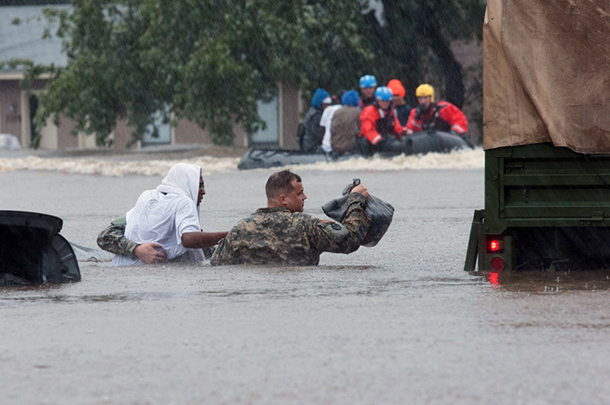
Clinton drew a link between Hurricane Matthew and climate change in her speech in Florida on October 11th, just days after the storm pummeled the Southeast with rain. Above, National Guardsmen help residents escape the floods in Fayetteville, North Carolina. (Photo: Staff Sgt. Jonathan Shaw, CC BY 2.0)
CLINTON: We need to invest in resilient infrastructure. Now sometimes that might mean building a seawall. Other times let’s be more creative. Like in New York harbor, where we’re replanting oyster beds to form natural barriers to storm surge. [AUDIENCE CHEERS] Sometimes we’ll overhaul an outdated sewer system to deal with flooding from heavy downpours. In Philadelphia they’re trying something else: green roofs, porous pavements, curbside gardens to help absorb storm water. [CHEERS] And then finally, we’ve got to lead the world to confront the climate challenge. If we don’t do it, no one will do it! Let’s move on with the kind of leadership that the world as well as our country deserves.
You know, when I was Secretary of State, I worked with President Obama to make climate change a top diplomatic priority. We fought to get China and India and other major polluters to agree for the first time in history to be part of the solution. In fact, we had to crash a secret meeting in Copenhagen, Denmark – slipped past the guards, it was all very cloak-and-dagger, but for a really important purpose. And because of that breakthrough and a lot of patient, persistent work, and because of American leadership, 195 nations signed onto a global agreement last December. It’s called the Paris Agreement, and [AUDIENCE CHEERS] I am not exaggerating when I say, it is our last best chance to solve the global climate crisis. And what does Donald Trump want to do? He wants to cancel the Paris Agreement. [AUDIENCE BOOING] Climate change needs to be a voting issue! This election matters more than any has in a really long time. And just look if you will, look at the difference between your state, the “Sunshine state”, which has less solar energy than New Jersey has right now. And do you know why? Because you have a governor who ordered your state government never to use the words climate change! [AUDIENCE BOOING] So my friends, this is a big deal in our election and it’s going to be a big deal for our country and our world.
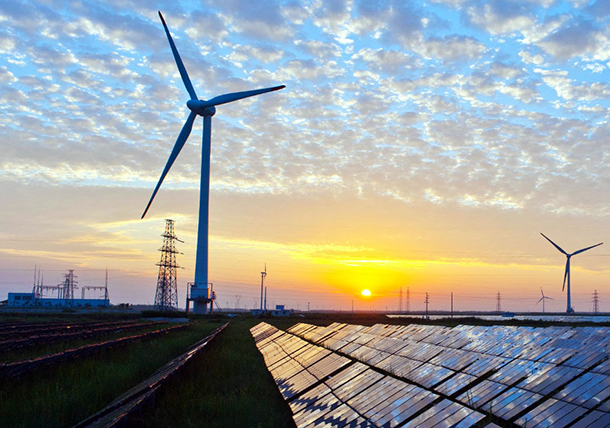
Clinton’s campaign platform includes plans for creating jobs by fostering a clean energy economy. (Photo: AishaAbdel, public domain)
CURWOOD: Democratic presidential nominee Hillary Clinton speaking at a rally on Miami, Florida on October 11.
Related links:
- The Clinton campaign’s climate initiatives
- Watch Hillary Clinton’s October speech on climate and clean energy
- Watch the second presidential debate of the 2016 general election
- Florida Governor Rick Scott’s gag order on climate rhetoric
[MUSIC: Harvey Reid, “Pieces Of Eight,” Of Wind and Water, Woodpecker Records]
CURWOOD: Coming up ... a new store with an old-fashioned way to reduce packaging and food waste. So stay tuned to Living on Earth.
ANNOUNCER: Support for Living on Earth comes from the Gordon and Betty Moore Foundation, and from a friend of Sailors for the Sea, working with boaters to restore ocean health.
[CUTAWAY MUSIC: Manasse/Nakamatsu, Three Preludes “Allegro ben rimato e deciso,” American Music For Clarinet & Piano, George Gershwin/arr.James Cohn, Harmondia Mundi USA]
Breaking Down Clinton’s Climate Approach
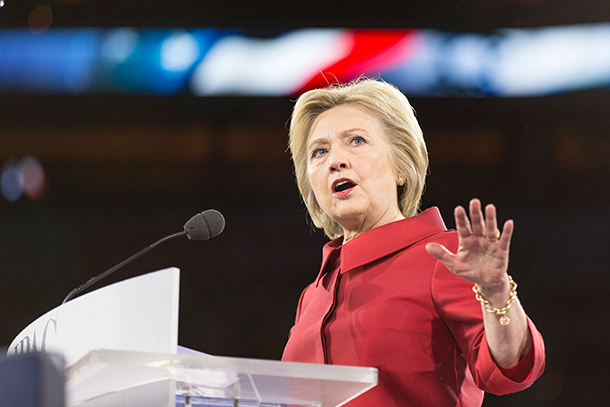
Hillary Clinton’s climate platform includes a carbon emissions reduction goal more ambitious than President Obama’s. (Photo: Lorie Shaull, Flickr CC BY-SA 2.0)
CURWOOD: It’s Living on Earth, I’m Steve Curwood. We’ve just heard from Secretary Clinton about her energy, environment and climate plans. So for more insight into both her priorities and how she would try to get things done, we turn to economist Joseph Aldy, a veteran of the Obama White House. He now teaches Public Policy at the Harvard Kennedy School of Government. Welcome back to Living On Earth, Joe.
ALDY: Steve, it's a pleasure to be here.
CURWOOD: So, what are the key elements of Secretary Clinton's climate and energy platform?
ALDY: Well, I think the first thing is that she recognizes climate change as a serious threat, that it's important that we bring resources to deal with the risk posed by climate change -- to make our economy more resilient to the threats posed by climate change, to make investments in clean energy that will both create jobs and create manufacturing. But also deliver the power, the fuels that allow our economy to continue to run but have less adverse impact on the global climate.
CURWOOD: So, can you briefly describe her 10-year clean energy challenge and how she gets this done without Congress helping her?
ALDY: Well, I think what she's trying to do is to say we've learned in a variety of policy contexts in the past that the states can be really powerful laboratories, that there is a kind of ingenuity at the state and local level, and by creating this opportunity to fund resources to the states we can sort of leverage that ingenuity and that learning to figure out what policies and what programs are most effective at promoting investment in clean energy, at promoting investment let's say in transmission that will enable an even greater increase in a renewable power generating capacity to try to break some of the deadlocks that keep us from really pushing the energy system forward.
I think a challenge for her though in doing this is that to say you want to produce 60 billion dollars for the states … you have to work with Congress because they hold the purse strings. They will have to make the appropriations, and so I think what she will need to do if she is inaugurated and enters into office is to figure the most effective way to engage with Congress to deliver those monies and maybe even part of a larger infrastructure investment program.
CURWOOD: Now, there's a saying that if you want to get something done as president you’d better do it in the first 100 days and the rest is sort of a mop-up operation. So if you were advising her on her plans: What should she do right away, should she win the White House?
ALDY: Well, I think the key thing is first to establish very clearly as president what her goals are, and she's already laid those out in the campaign, she's laid those out in terms of wanting to reduce our greenhouse gases emissions by up to 30 percent by 2025, an even more ambitious goal than President Obama. I think she needs to lay out then what she can do under existing statutory authorities to deliver on that goal. She's indicated that she will continue to defend the Clean Power Plan that President Obama has advanced to deal with carbon pollution in the power sector. There will be the opportunity to review fuel economy standards in the first year of the administration. I think she should lay out clearly what she expects to deal with fuel company standards to 2025 and even beyond. So I think part of it is to lay out your executive authorities and what you expect to achieve for those, but also I think she needs to figure out what she wants to do and needs to do through work with Congress.

A group of Virginia coal miners from 1974 on the evening shift at the Virginia-Pocahontas mine. Clinton vowed in the second debate not to leave coal miners behind as America transitions to renewable energy. (Photo: U.S. National Archives and Records Administration)
Some of that will be on appropriations, whether it's for the clean energy challenge for the states, whether supporting more innovation through ARPA-E, maybe making investments make our infrastructure more resilient. There is also going to be a question of whether or not there is a potential play for more longer-term comprehensive climate legislation, that would help deliver on the long-term goal she's established such as lowering our emissions more than 80 percent by year 2050.
CURWOOD: So how does she do this, Joe?
ALDY: Carefully. I think part of this is a question about where Congress will be. There's a lot of uncertainty about the composition of Congress as we approach the election. I think there's a question of what's the right policy tool and how one navigates the politics for that, and I think that there is this opportunity because there's an interest in tax reform on both sides the aisle that you might be able to incorporate some kind of climate policy and tax reform. Now, I'm an economist, these are the kind of things that economists dream about, but I think that there's this potential that you could look at say putting a price on carbon through tax reform as a way to finance meaningful reductions in the tax rates that individuals pay. You could engage some Republicans by saying we'll also cut some of the tax rates on corporate income. So, it could be part of a grand tax reform that could benefit both sides, both sides of the aisle get to claim victory and you might be able to do something meaningful on climate change as a part of that.
CURWOOD: So, we're unlikely to hear the word “tax” from Secretary Clinton's lips during the campaign, but I think what you're telling me is if she really wants to get something done over the long term just going to have to use that word “tax” once she's in office.
ALDY: Well, I think that the tools at the president's disposal now can make some meaningful reductions in our emissions over the next decade or so, but if we're really going to transform the energy foundation of the American economy, if we're really going to drive the kind of innovation that we need so that we have a breadth of low carbon and zero carbon technologies and equipment and capital that we can deploy to get to the very long term -- I mean, the scientists say that we eventually have to get to zero emissions, that if we're really going to be successful in combating climate change in United States and around the world we have to go to zero emissions. I think in order to that we need a long term policy signal, a long-term policy framework and the kind of patchwork that you can use through existing statutory authorities -- the Clean Air Act to go after power plants and vehicles or to do through Department of Energy to make appliance efficiency standards -- these all make a contribution but I don't think they're nearly as effective in reducing emissions or driving innovation as a long-term price signal.
CURWOOD: So, what do you anticipate a President Hillary Clinton would build upon that the Obama administration has done, and where does her platform diverge from Mr. Obama's approach?
ALDY: So, part of it is to recognize that Secretary Clinton was a partner with President Obama on international negotiations on climate, and when one looks at her goals, it's really taking the path that President Obama has laid, sort of the foundation and ramping up the ambition. So she's called for a more ambitious goal by 2025 for the U.S., she's talked about defending the Clean Power Plan that is still working its way to the courts. To be honest, one of the most important things she might be able to get a clean power plan is the nomination of the ninth Supreme Court justice.
CURWOOD: One of the knocks on Hillary Clinton by some advocates in the environmental community is that she seems to be very friendly to hydraulic fracturing to produce natural gas, something that some see is a real problem. What's your take on her approach to fracking?
ALDY: I think she recognizes that if we prudently develop the resource, it can deliver important climate benefits as a displacement for coal in the power sector, really important public health benefits when we think about the effects of burning coal on premature mortality, on asthma, on chronic bronchitis, so that if we're able to address the concerns about how producing natural gas through hydraulic fracturing can impact local water supplies or maybe create so-called fugitive methane emissions that we want to capture. If we have the right regulatory framework to address those environmental concerns, on that natural gas is a winner both for the climate and for public health. So, the approach is not we're just cannot let them do whatever they want or we're just going to let the states regulate. Because some have said, ‘oh, Washington shouldn't even be in this game.’
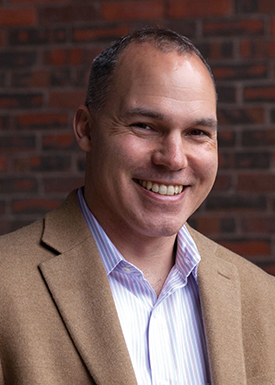
Economist Joseph Aldy is an associate Professor at the Harvard Kennedy School. (Photo: Harvard Kennedy School)
I think that Secretary Clinton's approach is we should have the right regulatory frameworks, we should think of how we use the Clean Air Act to address concerns about methane emissions both in terms of the climate impacts as well as their impacts on local air pollution such as ozone. Think about ways we might use the Clean Water Act to address some of the water issues, but if we do that we can develop a resource that is substantially cleaner and substantially better for the environment than coal. And to be honest, for all the rhetoric out there about regulations taking on coal and the sort of war on coal through the regulatory apparatus, it's amazing to me, it's capitalism at work here, it's the market. It's that innovators have lowered the cost dramatically of bringing natural gas out of the ground and it is competing and beating coal. It's not because of regulation. It's because natural gas is cheap, natural gas can go to power plants are already built and as a result we the American people I think are benefiting from that.
CURWOOD: So, in the recent debate Secretary Clinton spoke about how she plans to bolster and support former coal communities and coal miners. What you think her plans are there?
ALDY: I think what's important is to recognize that there are these communities, especially in Appalachia, where the community for a century or more has been built around the coal mining industry, and given the reduction in coal production we've seen in the US, what is likely to continue as we take on the challenge of climate change. There's this risk of these communities suffering high unemployment and having workers who knew how to do one thing. So she has pledged to invest $30 billion to revitalize these communities, to think about making investments in broadband, when we think about opportunities through the internet to increase commerce, to make investments in training so that these workers can develop a richer set of skills that they can bring to new sources of employment.
I think it's something that's actually much more substantial then what we've done in the past which is to say we're about to do an important policy and whether it's true on trade or on the environment, we'll have a job retraining program and it ends up being pretty modest, it doesn't have much resources, it doesn't seem to have that much of an effect. I think what Secretary Clinton has proposed is much more ambitious in scale when we think about $30 billion dollars of investment in a region and in people that it really has the potential to transform Appalachia and enable them to transition. When we think about the clean energy transition, for them it's an employment transition and I think what she's proposed to do, if she can secure the kind of funding from Congress to make this happen could be one of those things that really changes Appalachia for the better.
CURWOOD: Joseph Aldy teaches public policy at Harvard University's Kennedy School. Thanks, Joe.
ALDY: Thank you, Steve.
CURWOOD: There’s a longer version of this interview at our website LOE.org. There you’ll also find links to Secretary Clinton’s speech in Florida, and her campaign website with details of her environment and energy plans.
*The long version of this interview will be available on Monday, October 17th*
Related links:
- Joseph Aldy professor profile
- More from Aldy on Clinton’s climate agenda
- Clinton’s Climate Platform
- Politifact on H. Clinton’s statements on fracking
[MUSIC: Tomoko Sugarawa “Ebb Tide,” Classical & Instrumental (Volume VIII, #2), Robert Maxwell, Oasis Disc Manufacturing]
The Fillery: Shopping Without Waste
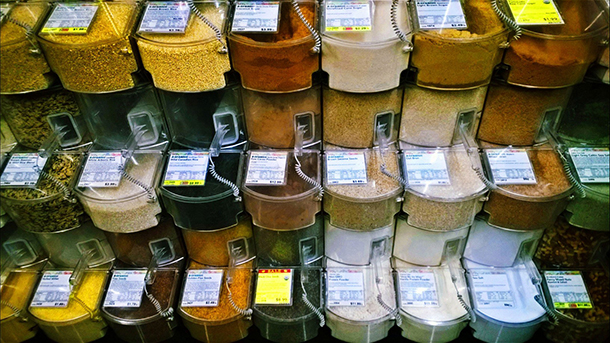
Many of the bulk food stations at the Fillery will look similar to this one. (Photo: Sara Stasi, Flickr CC BY-NC 2.0)
CURWOOD: Now if you’re like most people, you probably have a fridge and cupboard with a number of half-used packages. Even if you only need a cup or two of some ingredient, it comes by the pound or quart, and all too often eventually what’s left goes stale and into the garbage. That waste was part of the reason Sarah Metz decided to launch a store called “The Fillery.” It’s designed to reduce waste and save money, and its doors are expected to open in Brooklyn later this year. You see, at the Fillery, shoppers will bring their own reusable containers and only buy what they need. Sarah Metz joins us now. Welcome to Living on Earth.
METZ: Thank you for having me, Steve.
CURWOOD: So, this sounds a little like my old co-op, bring your container to get what you need.
METZ: Fantastic. Yes, a lot of co-ops do have a bulk section, unfortunately many of them don't have the ability to allow their customers to bring their own containers.
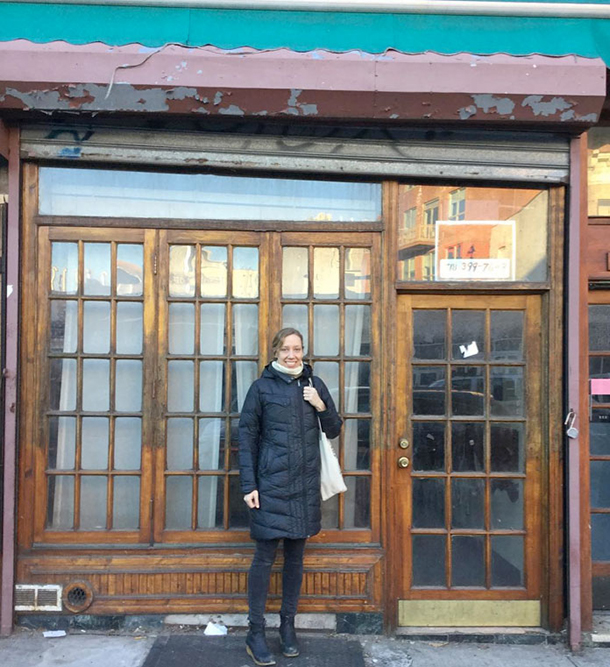
Founder Sarah Metz shopping for locations for the Fillery (Photo: Stephanie Metz)
CURWOOD: So, tell us about the Fillery. What kinds of goods are you planning to sell?
METZ: We'll have everything from nuts and seeds to baking ingredients, whole grains, coffee and tea, probably more than 100 different spices and we'll also have liquids like syrup and oil and vinegar, even a few household cleaning products will be available for refill.
CURWOOD: How about milk as well?
METZ: Well, milk not for refill. There is a farm in the region that does milk in glass bottles, kind of like the old days. You return your glass bottle and then you get a bottle of fresh full milk.
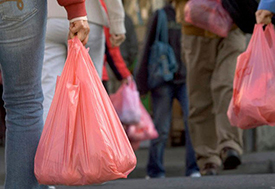
At the Fillery, customers will bring reusable containers instead of being given disposable plastic ones. (Photo: Day Donaldson, Flickr CC BY 2.0)
CURWOOD: Maybe even a milkman too.
METZ: [LAUGHS] It might make things more interesting.
CURWOOD: Now, what about fresh produce. What will you have along those lines?
METZ: We will be able to offer our customers fresh produce through a CSA program. So CSA is community-supported agriculture which supports local and regional farmers and then the farmer once a week delivers their produce to our store and then customers will be able to pick up their produce at our store.
CURWOOD: Any markup there?
METZ: We haven't decided that yet, we want to keep it as affordable as possible, and I really want the farmer to benefit of course from this. We're still investigating those options.
CURWOOD: What inspired you to open the store?
METZ: I've been an eco-conscious person for a long time, and I moved to Brooklyn about 10 years ago and when I saw the amount of waste being generated in New York City I was just shocked. I thought back to a store I shopped at in Michigan and it was a small bulk store and I really love that concept and still after 10 years of living in my neighborhood nothing like that exists, so I just decided to do it myself.
CURWOOD: So, how much waste do stores typically produce, Sarah? I mean, what are talking about here?
METZ: Right. That varies quite a bit depending on what type of store you're talking about or what type of business, but a report that was in Politico I think released just a couple months ago estimates that waste collection trucks haul approximately 10,000 tons of business waste every single day in New York City, so you can imagine there are ... probably a very conservative estimate would be 100,000 businesses so about 200 pounds per business per day on average.
CURWOOD: That's a lot of waste. I guess Oscar the Grouch must love New York City.
METZ: [LAUGHS] He must enjoy it there.
CURWOOD: So, how much do you expect to reduce food waste? We see figures that about a third of all food is wasted one way or another.
METZ: Right. I think that teaching people to buy only what they need is going to be a big part of that. Community education is a big part of what we hope for the Fillery to offer and part of that will be teaching people how to plan their meals and how to buy in quantities that are usable for them before the product goes bad. So we are hoping that that will contribute to reduction of food waste.
CURWOOD: So what do you think other businesses can learn from what you're doing here?
METZ: One of the problems with waste in terms of the business contribution is really generated at the supply chain level. So when we order products that we want to offer customers there of course is lots of packaging waste and so that is not necessarily always waste that is seen by the consumer, but that is waste that the business has to deal with. I hope that other businesses will start to look at that and be more vocal with their distributors and their suppliers in addressing the packaging waste problem in terms of the shipment. So often I receive an order that I placed online and it's a tiny shoebox in this huge box with all these airfield pouches, and it's just so unnecessary and so wasteful. So I do hope that more businesses will be more vocal to the supply chain.
CURWOOD: Sarah why do you think food packaging waste is such a problem?
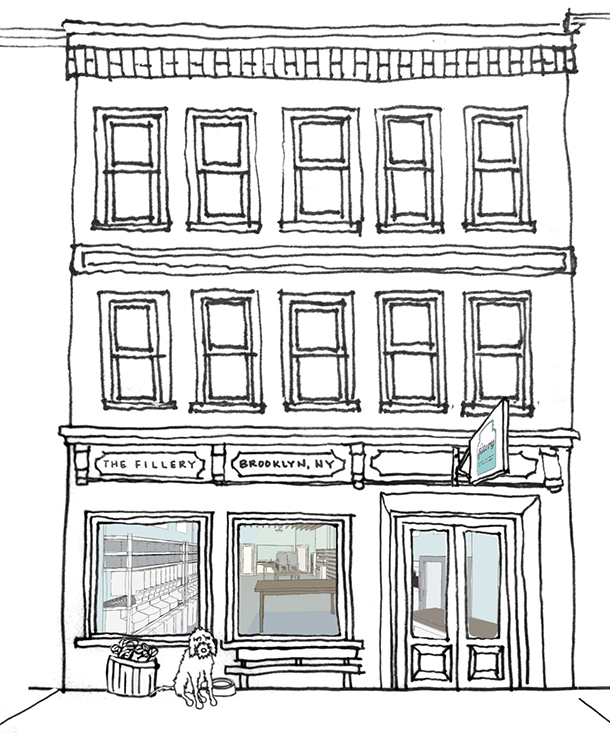
An illustration of the Fillery’s storefront (Photo: Stephanie Metz)
METZ: Well, in a place like New York, life is very fast-paced. People are looking for fast and easy things so a lot of times that's something that is packaged in many different layers. I think one misconception is that that also means a fresher and cleaner product when this is not necessarily the case, so what they don't realize is that a packaged food item has been sent from the producer to the packaging facility and then from there to another facility and then to the distributor. A lot of the shelf life for a packed item of has been eaten up just in transport, whereas this is not the case when they are buying it from the bulk store.
CURWOOD: Hey, what will you do when people come to your store without containers? I mean, it's likely to happen.
METZ: It is very likely to happen and I think that's one concern that many people have is just the feasibility of carrying around their own containers if they're not necessarily planning to go grocery shopping. We will have compostable paper bags available for dry goods for free for all customers. We will also have other containers for purchase so everything from jars and tins and bottles for the liquids - nothing plastic.
CURWOOD: So, Sarah, you're an entrepreneur and entrepreneur equals challenge, so what are the challenges that you are facing so far?
METZ: One of the biggest challenges so far has really been researching this type of business because a business like this so far doesn't really exist in the US, not with the same ideals and the same business model. They have been very successful in Europe, but researching the feasibility of a store like this in the US has been difficult because there's very little to compare it to.
CURWOOD: So, what kinds of responses have you received to the notion of the Fillery?
METZ: The response has really been fantastic, and I have to say somewhat overwhelming. I certainly didn't expect this much attention. Emails just about every day from residents in the community wanting to help out in whatever way they can, from people offering their services, everything from architecture to design services, so it really has been a fantastic response.
CURWOOD: How does a store like yours help community?
METZ: I very much want it to be a place where community enjoys being, a sort of a gathering place, whether it's in my store to learn new recipes or starting dinner clubs at their homes and then cooking again and spending time together in that way.
CURWOOD: Or I imagine learning how to reduce food waste?
METZ: Yes, of course.
CURWOOD: You're planning to offer workshops. What are you talking about?
METZ: Well, we recognize that offering people tools and resources doesn't really go very far unless you teach them how to use them, so we will have a variety of workshops some of them will be free and some of them will be paid workshops. We will be bringing in people from the Department of Sanitation in New York and from recycling organizations to help people understand how to sort their waste properly. That is one problem. Recycling rates are very very low. A huge percent of waste that goes to landfills could actually be recycled, and so a big part of that is education. We will also have local chefs and nutritionists doing workshops on how to cook with items that we have. A lot of the items that we carry will be fairly unique and unknown to people, and so to encourage people to cook with some of the whole grains that they've never used before, we will host workshops on how to do that.
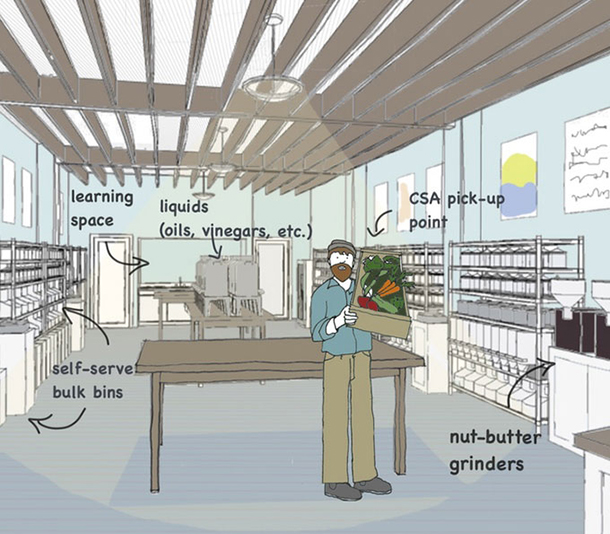
An illustration of what the inside of the Fillery might look like. (Photo: Stephanie Metz)
CURWOOD: Sarah Metz is the founder of the Fillery, a novel grocery store that's due to open, well, sometime later this year in Brooklyn, New York. Sarah, thank you so much.
METZ: Thank you so much for having me.
Related links:
- The Fillery’s official website
- Like the Fillery on Facebook
- Learn more about food waste
[MUSIC: Joshua Rifkin, “The Entertainer - A Ragtime Two-Step,” (LP Version), Scott Joplin PIano Rags, Scott Joplin, Nonseuch]
CURWOOD: Coming up ... school children and their quest to help baby turtles. That’s just ahead here on Living on Earth. Stay tuned.
ANNOUNCER: Funding for Living on Earth comes from you our listeners, and United Technologies - combining passion for science with engineering to create solutions designed for sustainability in the aerospace, food refrigeration and building industries. UTC companies such as Otis, Carrier, Pratt & Whitney and UTC Aerospace Systems are helping to move the world forward.
This is PRI, Public Radio International.
[CUTAWAY MUSIC: Haugaard & Hoirup, “Johsefin’s Waltz,” Rejsedage/Traveling, traditional, published by Haugaard & Hoirup]
Beyond The Headlines

Six American scientists were among this year’s batch of Nobel Prize recipients. (Photo: Adam Baker, Flickr CC BY-SA 2.0)
CURWOOD: It’s Living on Earth, I’m Steve Curwood. Time now to see what’s happening in the world beyond the headlines with our guide, Peter Dykstra. He’s with DailyClimate.org and Environmental Health News, that’s EHN.org and is on line now from Conyers, Georgia. Hi there, Peter.
DYKSTRA: Hi, Steve. You know, one of the recurring themes from supporters of big coal is that they provide cheap energy, and if coal-burning power plants go away and regulators crack down on fossil fuels, your electric bill is going to go through the roof. Well, pending litigation and the ruling of the DC court of appeals, the Clean Power Plan is reality and coal plants have been dropping like enormous, soot-covered flies -- but guess what?
CURWOOD: I’m listening Peter. I seem to remember even President Obama said prices would skyrocket back in 2008.
DYKSTRA: Right – but the U.S. Energy Information Administration says that for the first time in fourteen years, residential electricity prices went down in the first six months of this year.
CURWOOD: Hmmm, so what caused the drop, do you think?
DYKSTRA: Well natural gas is setting the market right now, and it’s setting it cheaply. Wind and solar are growing in capacity and shrinking in cost, but not enough to impact the nationwide market just yet. EIA warns that the drop, while it’s unusual, is not necessarily a permanent trend.
CURWOOD: Yeah, but those predictions that we’d be either paying through the nose or shivering in the dark aren’t happening. Hey what do you have for us next?
DYKSTRA: Something on a related note that might really be a trend. The Union of Concerned Scientists says Americans bought a record 45,000 plug-in electric vehicles in the third quarter of 2016. That’s a record, and it’s happening despite comparatively low gasoline prices. Another source, an industry website called Autoblog, puts the numbers a little lower, at 36,000, but that’s still a 38 percent increase over the previous year.
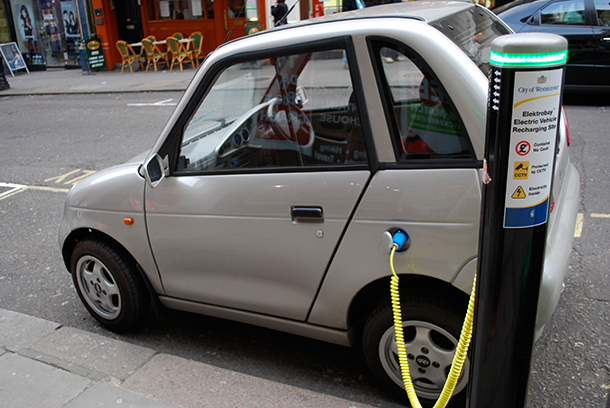
Americans bought more electric vehicles in the third quarter of the 2016 fiscal year than any other year. (Photo: Alan Trotter, Flickr CC BY 2.0)
CURWOOD: Sounds like the fact that sales are going up while gasoline stays fairly cheap is the surprising news here. What’s going on?
DYKSTRA: Well it might be a combination of lowering cost of the EVs, extending range of the EVs, and just deeper concern abut climate change. As EV prices come down and plugin stations become easier to find, the trend is likely going to continue. But I want to sneak in another observation on an unrelated topic.
CURWOOD: Go ahead.
DYKSTRA: We’ve heard bit a lot about immigration, now here’s a quick note on something that immigrants are doing to America, and this is something that hasn’t gotten its fair share of attention when America discusses immigration. The Nobel Prizes were announced a week ago, and six American scientists were among the honorees: they’re an economist born in Finland, another economist born in the UK, two physicists born in England, a chemist born in Scotland, and a physicist born in Scotland.
CURWOOD: All immigrants, I’m guessing?
DYKSTRA: That’s right and they’re taking away our Nobel Prizes!
CURWOOD: [LAUGHS] Okay and finally, our weekly dip into the trough of history. What’s new, or maybe I should ask what’s old?
DYKSTRA: Well 43 years ago, October 1973, Israel squared off in a brief war against Egypt and Syria. In response to U.S. support for Israel, Saudi Arabia and other Arab oil states banned oil shipments to the U.S., causing long lines at gas stations and prompting the price of oil to quadruple from three dollars a barrel to $12 a barrel.
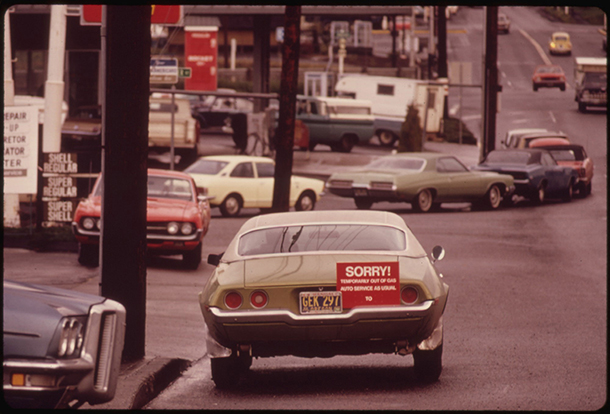
Middle-eastern oil nations like Saudi Arabia banned oil exports to the U.S. over their support of Israel in the 1970s, creating a temporary scarcity of gasoline for American vehicles. (Photo: David Falconer, Photographer (NARA record: 1427627) (U.S. National Archives and Records Administration) [Public domain], via Wikimedia Commons)
CURWOOD: And to think that today we call fifty bucks a barrel a bargain!
DYKSTRA: Right, and this set off a chain of events in the US like the national 55 mile an hour speed limit, the creation of the Department of Energy, and the first serious talk about alternative energy, conservation and reducing oil imports.
CURWOOD: And just how much of that serious talk resulted in serious action back then?
DYKSTRA: Not much at all, and not much for a long time. The 55 mile an hour speed limit saved not just gasoline, but it also saved lives. But eventually America declared that it couldn’t drive 55, and the 55 mile an hour speed limit went away. Both oil consumption and car miles driven increased for decades to come; oil imports waned only recently, bigger, less efficient vehicles like pickups and SUVs and minivans became all the rage and clean energy is just now beginning to fulfill years and years of predictions.
CURWOOD: But fuel efficiency is much better and you know, maybe we’re finally turning that corner. Thanks for this optimistic take on the world beyond the headlines today Peter.
DYKSTRA: Any time, Steve. Talk to you soon.
CURWOOD: Peter Dykstra’s with Environmental Health News, that’s EHN.org and the DailyClimate.org. And there’s more on these stories at our website – LOE.org.
Related links:
- EIA says power costs declining
- NY Post 2014 story -- “Energy prices will skyrocket”, predicted
- Politico: Obama predicted energy prices would skyrocket in 2008
- Electric vehicles sales record
- 1973 oil embargo
- Nobel Prizes 2016
[MUSIC: Jon Manasse/Jon Nakamatsu, “I Got Rhythm,” from “Girl Crazy,” American Music For Clarinet & Piano, George Gershwin/arr.James Cohn]
CURWOOD: In a minute, the drought and some threatened turtles, but first this note on emerging science from Charlotte Rutty.
Science Note: Ancient Turtle Revelation
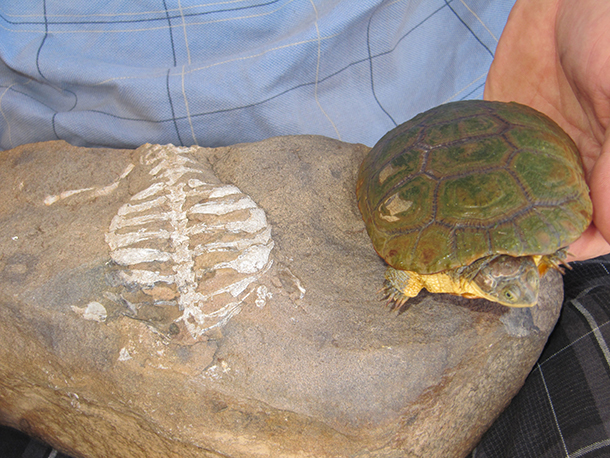
Turtle shells developed out of a modified rib cage (Photo: Luke Norton)
[SCIENCE NOTE THEME]
RUTTY: Kobus Snyman was just eight years old when he found a fossilized turtle on his father’s farm in South Africa. The fossil he uncovered was 260 million years old.
In fact, it’s a member of the oldest species of turtle that we know of – a partially shelled reptile called Eunotosaurus africanus. This specimen preserves parts of the ancient turtle skeleton that researchers have never seen before. It’s helping scientists at Wits University in Johannesburg piece together the origin of turtle shells – and it’s not for protection, as you might expect.
We already know how turtles evolved to have shells. Unlike other armored quadrupeds like armadillos and pangolins – whose shells are modified scales – turtles developed theirs by broadening the ribs and widening their bones into flat plates.
But scientists say why turtles developed shells is a puzzle. Across time and geography, there’s little variation in the rib cages of four-legged animals, because ribs are vital for breathing and movement. The broadened rib cage in turtles interferes with their lungs and makes walking slower and more awkward.
But Snyman’s specimen points to a possible explanation for this clunky trait: an ancient turtle hand. Big, strong, and clawed, it looks like the forelimb of an animal that digs.
Studying the anatomy and cell structure of other broad-ribbed animals such as anteaters, researchers found that wide rib cages are associated with burrowing. In the arid climate of ancient South Africa, the first turtles likely developed shells as a way to escape the heat underground. The shell’s protective function is just a byproduct – a handy side effect of a trait that evolved for different reasons entirely.
That’s this week’s note on emerging science. I’m Charlotte Rutty.
[SCIENCE NOTE THEME]
Related links:
- The new study, entitled “Fossorial Origin of the Turtle Shell”:
- A time lapse of turtle shell evolution, created by the study’s lead author Tyler Lyson
Turtles Hatch!
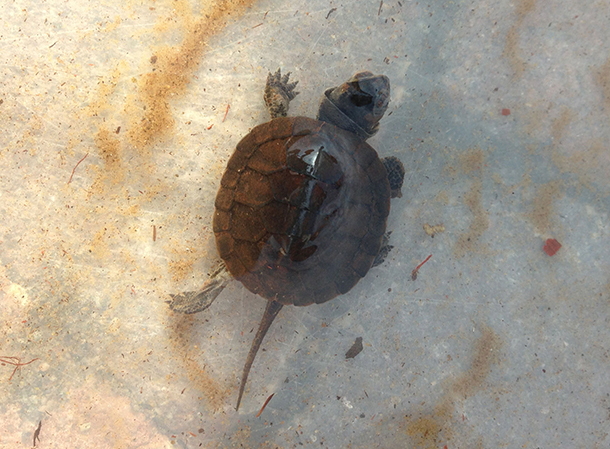
A baby Blanding’s turtle takes its first swim (Photo: Don Lyman)
CURWOOD: It’s been a dry year for much of America, including the Northeast. And that’s been tough for all sorts of things, from farming to hatching baby turtles. Earlier this year, Living on Earth went out with a team of biologists who are working with some Massachusetts schoolchildren to give a boost to the regionally threatened Blanding’s turtles. This project monitors the turtles as they nest and then rears any hatchlings in classrooms over the winter for release in the spring, when the turtles are a lot bigger and stronger. The other day Bryan Windmiller went out to the Great Meadow in Concord, Massachusetts to check on the nests with a couple of young assistants.
MARCO: I’m Marco. I am 12.
ANA GRACIA: I’m Ana Gracia, and I’m 10.
WINDMILLER: It’s now ... today’s, this is September 11, right? So this is starting to get well into the period where turtles are often hatching.
CURWOOD: Bryan is the executive director of Grassroots Wildlife Conservation, and he’s concerned about what effect the drought might have had on the nest of turtle number 2028. That’s the mother we encountered when she laid her eggs back in June and this time Living on Earth’s Don Lyman went along with Bryan as well.

A sponge helped keep Turtle 2028’s nest damp during the dry summer (Photo: Don Lyman)
WINDMILLER: Right now, just to make sure that things are okay we’re just gonna scratch down and take a look just at the topmost couple of eggs, and just see if those eggs look okay.
LYMAN: Bryan opens the wire mesh cage that surrounds the nest to protect it from predators like skunks and raccoons. There’s a large, yellow sponge on top of the soil to keep the soil moist, says Bryan.
WINDMILLER: We water the sponge, and we usually overwater it so we’re actually watering the nest a little bit, too -- the soil’s been so dry so just to make sure that the eggs aren’t dehydrating. The only thing is we didn’t start doing that till August, and it was incredibly dry before then, too. So our concern is that some of the embryos might have perished back in July, when it was really hot and dry as well. So, Ana Gracia and Marco, you guys can take some turns.
LYMAN: Marco and Anna Gracia carefully dig into the nest with their hands. And pretty soon…
ANA GRACIA: It’s a turtle!
MARCO: It’s alive.
ANA GRACIA: Ooh, let me see him!
WINDMILLER: That, I was going to say, is the other thing that we sometimes find is you dig down and you find that the turtles have hatched already.
ANA GRACIA: He’s okay, he’s so cute!
WINDMILLER: Looks wonderful. I’ll go turn the hose on.
ANA GRACIA: He’s teeny!
MARCO: He does weigh as much as a quarter.
ANA GRACIA: He weighs less than a quarter.
[WATER SOUNDS]
WINDMILLER: Yeah, you can soak it for a second and we’ll also soak the nest.
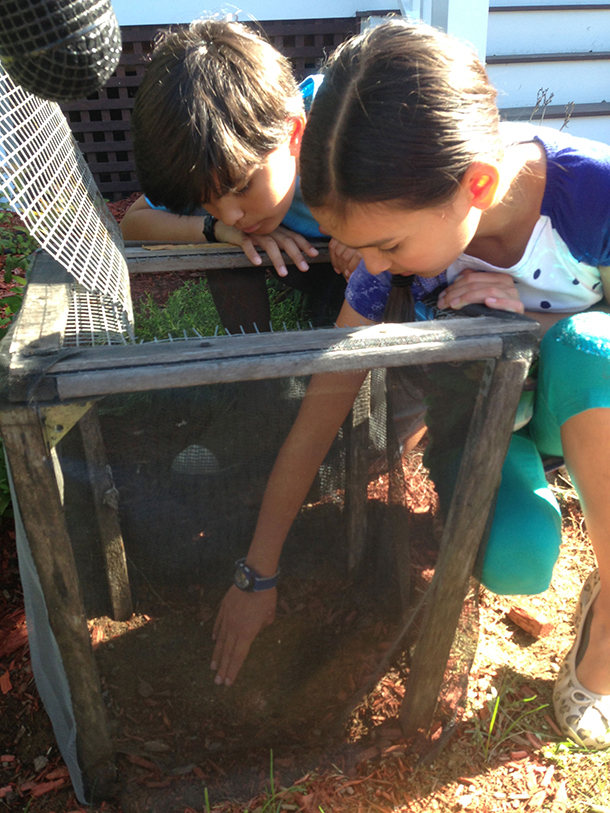
Marco, 12, looks on while his ten-year-old sister Ana Gracia carefully digs in the dirt of Turtle 2028’s nest. (Photo: Don Lyman)
LYMAN: Ana Gracia rinses the little Blanding’s turtle off with a garden hose and puts it in a plastic tub with some water.
ANA GRACIA: He’s swimming. I was kinda surprised they could swim, like, the second they got out.
WINDMILLER: Moisten the sponge. That one looks really good!
LYMAN: Bryan thinks it’s best to leave the nest alone at this point, so the rest of the hatchlings can dig their own way out. When they do, these hatchlings will go to school – literally. Bryan entrusts them to school kids like Marco and Ana Gracia who care for them in their classrooms and give them a head start in life. He says it’s a good thing they don’t have to find their way to the nearest pond -- baby Blanding’s turtles aren’t very good at finding their way to the water.
WINDMILLER: You’d inevitably find some turtles that went completely a wrong way, and then they’d wander for a while, maybe a day or two and if they don’t get eaten – which many of them do – then they might eventually turn around and figure it out.
LYMAN: As tiny hatchlings, baby turtles face a variety of hazards, as they’re only as big as a quarter and their shells are flexible.
WINDMILLER: So with that very thin, flimsy, flexible shell and tiny size, they get eaten by garter snakes, bullfrogs, blue jays; crows, people’s cats, people’s dogs, anything you can imagine; some of them are killed by insects; they’re killed sometimes by ants, when they get in the water, there are various aquatic insects that can kill them. Plus, they get run over by cars, they get run over by people on bicycles. I mean, they’re just so tiny and so vulnerable.
LYMAN: In another nest that Bryan was monitoring, he found a startling threat to Blanding’s turtle eggs that may have been related to the drought.
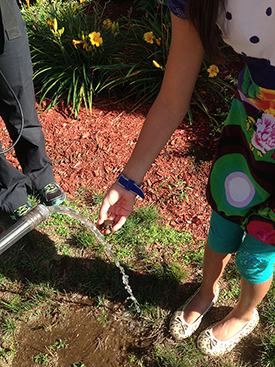
Ana Gracia rinses off the little turtle hatchling she found in the nest (Photo: Don Lyman)
WINDMILLER: There were about six or seven dead eggs in there. This nest was a little unusual. Several of the eggs that were dead, there were grassroots all through the egg shell, and what we suspect happened is that the babies were literally killed by the grassroots.
LYMAN: This happens with sea turtle eggs, Bryan says. They can be killed by dune grasses.
WINDMILLER: And the roots will actually pierce the eggshells, and suck up the nutrients from the egg and kill the embryo in the process. We normally don’t see that in inland turtles so much, it’s not reported so much. But as a guess, you know it’s been so ridiculously dry that the grass roots you know weren’t able to get moisture normally from the soil, and these grassroots happened to be right next to turtle eggs, and opportunistically, they grew right through the shells and sucked up the nutrients and killed those eggs.
LYMAN: A couple of weeks later, we’re back at the nest with Bryan Windmiller and program coordinator Emilie Schuler. Bryan says no baby turtles have emerged since Marco and Ana Gracia found that first one nearly two weeks ago.
WINDMILLER: Typically, we don’t see more than a week or so that goes by between when one hatchling emerges and everyone else does. And we’ve found that rain often seems to motivate the hatchlings to come out of the ground, and we actually had one fairly decent rain just about three days ago, four days ago.
LYMAN: And time is running out, Bryan says, for the cold-blooded turtle hatchlings.
WINDMILLER: At this point, because the weather’s cooling down, it becomes harder and harder for the hatchlings that are underground to have the energy to dig themselves out.
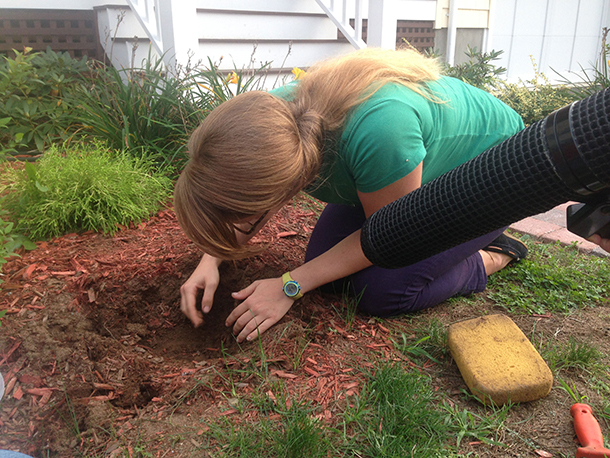
Grassroots Wildlife Conservation Program Director Emilie Schuler gently digs into the nest in search of any remaining hatchlings. (Photo: Don Lyman)
LYMAN: Bryan and Emilie take off the mesh cage that’s been protecting the nest.
WINDMILLER: OK, you gonna go for it, Emilie?
SCHULER: OK.
[DIGGING SOUNDS]
SCHULER: Oh, what’s this. Oh, that’s the...
WINDMILLER: Temperature logger.
SCHULER: Temperature logger. Okay, well, we’ve got that.
WINDMILLER: So this records the temperature every hour. It will allow us to predict with reasonable accuracy whether the turtles are boys or girls.
[DIGGING SOUNDS]
SCHULER: So I think I’m seeing our first little friend here. There’s a something, some egg and some movement.
WINDMILLER: Oh! That’s looking good.
SCHULER: There’s movement. There he is.
WINDMILLER: It’s a little one.
SCHULER: Awww.
WINDMILLER: Yeah, wonderful! Looks like that one too has been hatched for a little bit, just been sitting there.
LYMAN: Emilie digs down further into the nest.
WINDMILLER: So Emilie just dug up...here’s an egg, that you can feel, it’s got a formed embryo inside of it. But I’m suspecting that, uh...
LYMAN: It might not be alive?
WINDMILLER: Yeah, that it’s not viable anymore. This also, this nest may be pretty small because this was a first-time mom, and first-time moms often lay pretty few eggs compared to the normal average of about ten.
LYMAN: Oh, looks like some more eggs there.
WINDMILLER: Mmm hmm.
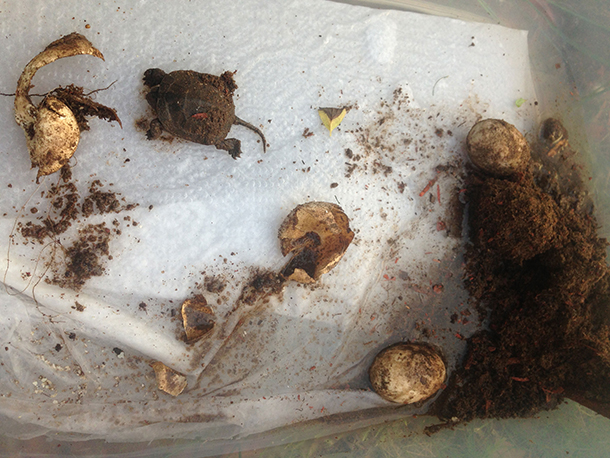
Turtle 2028’s first clutch of eggs yielded two live hatchlings, an eggshell without an embryo, an egg containing an embryo that never developed into a turtle, and a tiny hummingbird-sized infertile egg. (Photo: Don Lyman)
SCHULER: Yep, but, again.
WINDMILLER: So this one doesn’t have an embryo in it.
LYMAN: How can you tell?
WINDMILLER: You feel it’s really light, it’s all dried up.
LYMAN: Oh yeah.
WINDMILLER: And that may be pretty much the nest, right?
SCHULER: There’s something else down here.
WINDMILLER: Ah, is there? Oh, yep.
SCHULER: Oh!
WINDMILLER: Oh, I’ve seen that before.
SCHULER: Look at that! A tiny egg!
LYMAN: So tiny. Why is it so tiny?
WINDMILLER: So that’s also something that we saw once before with a first-time mother, right across the street from here, who, you know, you could tell she was sitting there working, laying, and then very carefully burying things. And we always, when we put the screen over the nest we dig down just to make sure that she actually laid eggs, and we were quite sure that she’d done something, but I dug down, and I didn’t see anything, and I kept digging down, and I just had one little tiny egg. You know, this is the size of a parakeet egg.
LYMAN: Or maybe a hummingbird egg.
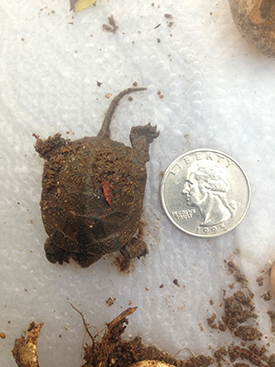
The tiny turtle hatchling Emilie excavated was only a bit bigger than a quarter. (Photo: Don Lyman)
[LAUGHING]
WINDMILLER: Or maybe a hummingbird egg, this is not the size of a Blanding’s turtle egg! I think it’s just something physiological about first-time moms.
LYMAN: Bryan says he’ll dissect the egg that has an embryo inside, but not yet, because...
WINDMILLER: My wife, who is a wildlife veterinarian, always reminds me when you work with reptiles, their metabolisms are so slow, it’s not always easy to tell when they’re dead or not.
LYMAN: Oh!
[LAUGHING]
WINDMILLER: So, so I will take that egg, actually. And I’m gonna take a little bit of the soil over here, and just in case, you know, I’m wrong, I’m just gonna put it in a container for a little bit, just to see if anybody does hatch from it before I break the shell open.
LYMAN: All in all, Turtle 2028 laid four eggs in her nest.
WINDMILLER: That’s less than half the size of a typical Blanding’s turtle clutch. And two out of the four survived, which is also low.
LYMAN: Normally about 80 percent of the eggs produce hatchlings. The low survival rate of the eggs of these threatened turtles seems to be a trend this year in New England.
WINDMILLER: We did hear from U.S. Fish and Wildlife Service, so they’re monitoring the only relatively large population of Blanding’s turtles left in Massachusetts, and I believe they had 59 nests that they monitored this year. And their average hatching success was just over five hatchlings per nest, and that’s very low. And I would put up drought as my first guess as to why that’s been the case.
LYMAN: Since as many as 80 percent of Blanding’s turtles don’t make it through their first winter, Grassroots Wildlife Conservation steps in. The turtles grow much faster when cared for by humans than in the wild, Byran Windmiller says.
WINDMILLER: By the time we let them go they’re usually the size of, say, a wild four-year old. The first year their survival rate is really high, it’s around 85, 87 percent. And by the second year after we let them go it’s around 96 percent.

Bryan Windmiller is the founder and Executive Director of Grassroots Wildlife Conservation. (Photo: Grassroots Wildlife Conservation)
LYMAN: The tiny Blanding’s turtle that Emilie unearthed from the nest of turtle 2028 may have come from a small clutch, but the nine months of boarding school that awaits it gives the little guy – or gal – a good shot at living a long and productive life.
WINDMILLER: The good news is we’ve got a baby who looks healthy. And this is the second one from this nest. And we have a lot of fourth graders in Concord who are really looking forward to meeting their turtles.
LYMAN: And we plan to follow the hatchlings into the classroom as school kids do their part to protect threatened wildlife. For Living on Earth, I’m Don Lyman in Concord, Massachusetts.
Related links:
- Watch a Blanding's turtle laying eggs
- Grassroots Wildlife Conservation’s Blanding’s Turtle Monitoring and Head Starting project
- 2014 report on GWC’s Blanding’s turtle project
- More about the Blanding’s turtle from the Massachusetts Division of Fisheries & Wildlife
- About Great Meadows National Wildlife Refuge
[MUSIC: Lawrence Blatt, “Flying Over Ellis Island,” Longitudes and Latitudes, LMB Music
Ellis Island”]
CURWOOD: Living on Earth is produced by the World Media Foundation. Our crew includes Naomi Arenberg, Bobby Bascomb, Aidan Connelly Savannah Christiansen, Jenni Doering, Emmett Fitzgerald, Jaime Kaiser, Don Lyman, Alex Metzger, Helen Palmer, Adelaide Chen, Jennifer Marquis and Jolanda Omari. Tom Tiger engineered our show, with help from Jeff Wade, Jake Rego and Noel Flatt. Alison Lirish Dean composed our themes. Find us anytime at LOE.org and like us, please, on our Facebook page -- PRI’s Living on Earth. And we tweet from @LivingOnEarth. I'm Steve Curwood. Thanks for listening!
ANNOUNCER1: Funding for Living on Earth comes you, our listeners, and from the University of Massachusetts, Boston, in association with its School for the Environment, developing the next generation of environmental leaders. And from the Grantham Foundation for the protection of the environment, supporting strategic communications and collaboration in solving the world’s most pressing environmental problems. Support also comes from the Energy Foundation, serving the public interest by helping to build a strong, clean, energy economy, from Gilman Ordway, and from SolarCity, America’s solar power provider. SolarCity is dedicated to revolutionizing the way energy is delivered by giving customers a renewable alternative to fossil fuels. Information at 888-997-1703. That’s 888-997-1703.
ANNOUNCER2: PRI. Public Radio International.
Living on Earth wants to hear from you!
Living on Earth
62 Calef Highway, Suite 212
Lee, NH 03861
Telephone: 617-287-4121
E-mail: comments@loe.org
Newsletter [Click here]
Donate to Living on Earth!
Living on Earth is an independent media program and relies entirely on contributions from listeners and institutions supporting public service. Please donate now to preserve an independent environmental voice.
NewsletterLiving on Earth offers a weekly delivery of the show's rundown to your mailbox. Sign up for our newsletter today!
 Sailors For The Sea: Be the change you want to sea.
Sailors For The Sea: Be the change you want to sea.
 The Grantham Foundation for the Protection of the Environment: Committed to protecting and improving the health of the global environment.
The Grantham Foundation for the Protection of the Environment: Committed to protecting and improving the health of the global environment.
 Contribute to Living on Earth and receive, as our gift to you, an archival print of one of Mark Seth Lender's extraordinary wildlife photographs. Follow the link to see Mark's current collection of photographs.
Contribute to Living on Earth and receive, as our gift to you, an archival print of one of Mark Seth Lender's extraordinary wildlife photographs. Follow the link to see Mark's current collection of photographs.
 Buy a signed copy of Mark Seth Lender's book Smeagull the Seagull & support Living on Earth
Buy a signed copy of Mark Seth Lender's book Smeagull the Seagull & support Living on Earth

